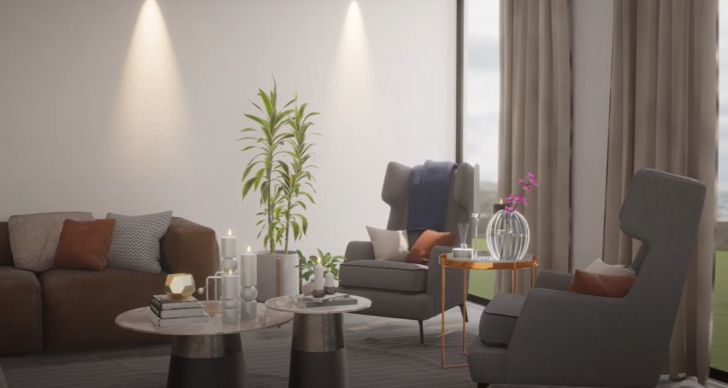Francesca Silvi & Mattia Santi
Professors of the Postgraduate Course in Virtual Reality for Architecture
Blog / Disruptive Technologies
Categories

Do you want to experience the magic of walking through your architectural designs before they're even built?
Are you tired of traditional design methods that limit your creativity and imagination?
Are you eager to explore the cutting-edge technology of Unreal Engine, Twinmotion and Rhino and its potential applications in architecture and other fields?
Then our Postgraduate Programme in Virtual Reality for Architecture is the answer!
Get ready to be blown away by the power of virtual reality and how it can transform your design process!
In this article you’ll understand why.
We interviewed Francesca Silvi and Mattia Santi, the professors of this virtual reality for architecture course, who will walk you through this exciting course and see how it can revolutionize your architectural practice.
Virtual reality (VR) technology can enhance the architectural design process in several ways.
First, it allows architects to visualize and experience their designs in a more immersive and realistic way.
Second, VR technology can enable architects to collaborate more effectively with clients, stakeholders, and other team members, by allowing them to share and explore designs in real-time.
Third, VR technology can also help architects communicate their design concepts more effectively to non-experts, such as clients, investors, or the general public.
This course can prepare students to use VR technology effectively, by teaching them how to use VR software, such as Twinmotion and Unreal Engine. Additionally, it can provide them with practical experience in using VR technology to visualize, explore, and evaluate architectural designs. Lastly, it can teach them how to create and modify 3D models, textures, lighting, and other elements of virtual environments.
In this course, students will acquire skills and knowledge related to using Rhino, Twinmotion, and Unreal Engine for architectural design and visualization.
Specifically they will learn:
Rhino skills: Rhino is a 3D modeling software that is widely used in architecture and design. In this course, students will learn how to use Rhino to create 3D models of buildings, landscapes, and other architectural elements. They will also learn how to modify and refine these models, and how to export them to other software platforms for further visualization or analysis.
Twinmotion skills: Twinmotion is a real-time visualization software that can be used to create high-quality renderings, animations, and VR experiences. In this course, students will learn how to use Twinmotion to create realistic lighting, textures, and materials for architectural designs. They will also learn how to use Twinmotion to create animations or walkthroughs that can help clients or stakeholders visualize a proposed design.
Unreal Engine skills: Unreal Engine is a game engine that can be used to create interactive and immersive experiences, including VR environments. In this course, students will learn how to use Unreal Engine to create realistic architectural environments, including lighting, sound, and interactivity.
The course likely aims to balance the technical aspects of virtual reality with the creative process of architectural design, by integrating VR into the design process, rather than treating VR as a separate tool or skillset, the course aims to integrate it into the overall design process.
Also, the course will encourage experimentation with different approaches to using VR in architectural design, emphasizing user experience and the importance of user experience in VR-based design, which requires both technical proficiency and a creative approach to design.
Overall, the course likely aims to balance the technical and creative aspects of VR and architectural design by integrating VR into the design process.
Graduates of this program will be prepared for a range of career opportunities in the fields of architecture, design, and technology, particularly in roles that involve the use of virtual reality for architectural design and visualization.
Students can take on roles as virtual reality designers, where they can use their skills in VR technology and architectural design to create immersive and engaging virtual environments for clients or stakeholders.
They could also work as architectural visualizers, where they can use their skills in Rhino, Twinmotion, and Unreal Engine to create high-quality renderings and visualizations of architectural designs.
Also, they could work as 3D modelers, where they can use their skills in Rhino and other software tools to create detailed and accurate 3D models of buildings, landscapes, and other architectural elements.
To keep abreast of technological advances in virtual reality, the course will stay up-to-date and incorporate latest changes and updates. This will be achieved by regularly updating course materials to reflect changes in VR technology and emerging best practices in the field, as well as encouraging research and experimentation related to VR technology and its applications in architectural design.
This can help students stay up-to-date with emerging technologies and new techniques for using VR in their work.
*
The Postgraduate Programme in Virtual Reality for Architecture is a game-changer for architects interested in exploring the limitless potential of virtual reality in their designs.
With this course, students gain a unique skill set and knowledge base that is essential for staying competitive in the industry. The programme balances technical and creative aspects of virtual reality in architecture, preparing students for a range of exciting career opportunities.
So why wait? Join our virtual reality for architecture course today and take your architectural designs to the next level!
Francesca Silvi & Mattia Santi
Professors of the Postgraduate Course in Virtual Reality for Architecture